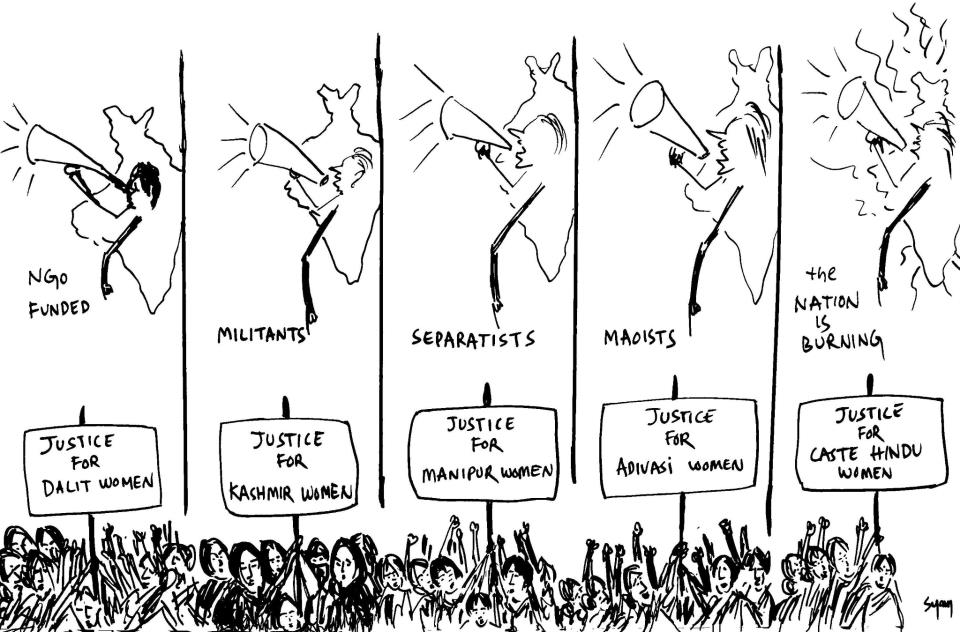Jackson RK
 Racism is a face producing machine. It gives a face to the living things, non-living things, and, this time, to an entity that is both a living and a non-living thing at the same time: virus. As the world shrinks into private rooms in the aftermath of the corona-virus pandemic, racism succeeded in giving a face to this virus. For the world, it is the bat-eating-Chinese; for India, it is the dog-eating-or-whatever-the-hell-they-eat-but-they-make-momos-chinki.
Racism is a face producing machine. It gives a face to the living things, non-living things, and, this time, to an entity that is both a living and a non-living thing at the same time: virus. As the world shrinks into private rooms in the aftermath of the corona-virus pandemic, racism succeeded in giving a face to this virus. For the world, it is the bat-eating-Chinese; for India, it is the dog-eating-or-whatever-the-hell-they-eat-but-they-make-momos-chinki.
Racist violence of intense hatred against the North Eastern diasporas has been rampant in major Indian cities. The pandemic has discharged a new wave of violent attacks as if the virus shoved the hitherto temporarily introverted hate into becoming an extrovert. The speedy response to the savage attacks is also one of racial paranoia, jokerfication of racial identities, and also of reducing and fixing the injured as forever victims, as people with injured identity with no agency of their own. But is anything ever new? It is in these normal times that I am choosing to sort of review a book that I believe is apropos.
Mistaken Identity: Race and Class in the Age of Trump by Asad Haider is a sweeping, dense but easily accessible text that probes into the logic of racism, the legitimacy of racial ideology, and of its intersecting play with class politics. But what made the book stand out among the usual academic gymnastics is the serious inquiry into the artificial concept of ‘race’. It problematise ‘race’ as an innocently given category. The book is lighted with rich references to the politics of Black Panther Party, the Combahee River Collective, the Black Power movement, Communist Party, Malcolm X, Barbara Fields, Amiri Baraka, and generally to the black working-class movement in America. These brilliant anecdotes though veil the lack of an original thesis. The title also may be slightly misleading as the book says close to nothing of Trump’s politics; it is, instead, more of a historical narrative. However, it is not wanting of any bearing on contemporary identity politics.
The book has the feel of an autobiographical reflection. It is not written by some white man, but by a Pakistani Muslim migrant. Haider manages to impart a genuine reflection of his own political and organisational experience, a soul (identity?) searching of sorts. The Introductory chapter made it sure to be noticed.
Although the last two chapters are somewhat lackluster, the first three chapters are truly revelatory. For some, it will be, as I say in meiteilon, a wakhal pheijom thokpa experience. It challenges us to seriously rethink our concepts and practices of identity politics and the ideology of race. It traces how the idea of identity politics in its modern usage, as first conceived by the lesbian black feminist group Combahee River Collective, has been deformed unrecognisably in the present state from its initial birth to the extent that Hillary Clinton even proclaims it. The class character it had in its initial conception has been completely stripped off; it now entails nothing more than a narrow focus on personal identity. It’s thoroughly (read intentionally) blind to the power structure of capitalism.
Identity politics lost its emancipatory potential as soon as it turned towards legal remedies, seeking redress for injured identity. It no longer has its base in the grass root mass movements; it is now reduced only as a handy tool for the elites. In light of this argument by Haider, the ST demand by some Meitei CSOs can be thought of as a classic case of this alteration. Seeking to fulfill its own narrow self-interest, the elites have deployed a smokescreen of ‘racial and cultural unity’ among the degraded masses⸺ even the university-educated students fall weak to their knees⸺ to hide their status and sell a dream of prosperity which, however, is a lie in the land of a shamelessly corrupted administration. They successfully managed to pit the have-nots against each other. Further, when the native bourgeoisie is shut off from entering the mainstream, the dividing tactics evolve into a much viler form called the cultural nationalism (or as Huey Newton called, “pork-chop nationalism”).
By advocating for racial unity and solidarity with an appeal to historical memories, cultural nationalism serves as a perfect launching pad for the elites while masking the political and economic contradiction among the community. It launched the career of people like Barak Obama and Jay-Z in America (and of the Samarjits in Manipur). Reflecting back again on Manipur, our uncritical acceptance of the leadership of thikadars in the ILP demand movement epitomises the kind of rot we are living in. Such reactionary nationalism serves as an ideological shield for the benefactors of capitalism and corruption. At long last, identity politics amounts to nothing more than replacing white oppressors with the black oppressor and brown oppressors with yellow oppressors. It’s oppression all the same.
Haider ramped up his assault even further in the third chapter which takes up the question of racial ideology. For people like us, ‘race’ is something of a default and understandably so. When the racist attacks are flying in from every direction, it is easier to recoil into our racial identity. We go even to the extent of embracing the insult, brutality, and contempt and reinvent it as a source of pride and solidarity with an unbridled passion. This reversal is a powerful factor in the tenacity of racial ideology. Haider cites Judith Butler’s argument on the paradox of subjectivation and subjection. This paradox is tied up with a “passionate attachment to power”. “This is the kind of attachment that children display towards their parents, who are an arbitrary repressive authority but also the models of selfhood and the first source of recognition, and therefore of love.” We love our parents although they are the first and most powerful authoritarian figures of our life. We are activated as subjects only when we are subjected to the totalising authority. We embrace the externally imposed injurious words because it constitutes us socially, “called by an injurious name, I come into social being…”
In much the same way, the author argues, that ‘race’ is a product of racism, not the other way around. To illustrate this point, Haider details the origin of the ‘white race’ in the legal documents of colonial Virginia. He builds on the argument that the idea of race was invented by the white European bourgeoisie to divide and control the emergent alliance between the white and the black labourers against forced labour. ‘Race’ was invented pretty much to preserve capitalism. Before this turn, racism wasn’t always associated with race as the English oppression of Irish demonstrates. Now the white labouring class was offered the cultural bonus of white supremacy and white privilege while the blacks were to live in servitude forever. But this was only a cultural concession with no material improvement. The white labourers continued to toil. Thus, the author strikingly argues that white supremacy and even the very idea of ‘white race’ is very much against the interest of the white labouring class as it is for the blacks. This legacy to this day continues to haunt the hope of any cross-race working-class movement in America.
To say the least, ‘race’ is a social construct. There is nothing inherently natural about it. There is nothing radical about equating physical characteristics and social effects. It is merely a reduction of human culture to biology. It is merely another category of the face producing machine. We can be anti-racist and still believe in the racial ideology. In my own experience within the student radical circles, racial particularism is fervent. Small vanguard group pops up in multiplicity with negative identarian polarity, all claiming to represent the true interest of their community. Racial paranoia and suspicion run wild among these groups which, from outside the bubble, seems like a Titanian effort to be rabble-rousers with empty politics.
If we continue this politics, as Haider contents, we will be trapped in the sadistic circular logic of race. We will end up enforcing what we supposedly aimed to oppose because we are still playing the game they designed. We become fixed into categories of deviants. Opposing racism with hardened racial identities is like Batman fighting crime. The point of the struggle is to escape the game or, better yet, destroy it! As Paul Gilroy says, “Action against racial hierarchies can proceed more effectively when it has been purged of any lingering respect for the idea of ‘race.’”
Autonomous identity politics has deep bondage with capitalism. Haider asserts astutely that, for a long history, it has been the go-to modus operandi for the incipient bourgeoisie. Without a critique of capitalism, without a class struggle, without a grass-root mass struggle, we will continue to be puppets for the bourgeois to deploy as it needs. He draws on Amiri Baraka’s inspiring journey from a black cultural nationalist to his ultimate realisation as a Marxist. His life experience elucidates that without class consciousness, identity politics is nothing more than an accumulation of anger (Anger Capitalism?). If “the personal is political,” it is in the sense that we are left with only fashioning and centering our personal identity as concrete politics. The case of Rachel Dolezal, a white woman passing as a black, may illustrate the cruel irony and the façade involved in such politics.
Haider ends the book with a call for universal emancipation, of an insurgent universalism. This is something the melancholic Left laughs at nowadays. Cynicism is now passing as pragmatism. Sadness and hopelessness are in vogue. Yesterday’s visionary is today’s deluded. Class solidarity among the upper class, where is the class solidarity of the maligned lower class?
“Being practical”, “reality”, “ground level” erects barriers to the possibilities of human actions. However, the world is not something concrete, a solid matter out there untouched by human interpretations. It is constructed by the various forces of the world, and in this case, by the ruling force of capitalism, racism and the authoritarian state. We are only limited by our imagination. At the same time, we have to be wary of our politics in the present order. Racist attacks are pouring down upon us and it is easy to slip down the hell hole of identity politics. It’s vital that we stand still for a moment to evaluate our politics otherwise we risk being reduced to legal categories of victimhood seeking recognition for injured identities and the “folks” for police cells to set up helpline numbers. Or worse we may regress into an awful parody of the kind of political treachery involved with the Haitian state leadership which imposed slavery upon its black labourers after the success of the anti-colonial revolution. But we can also choose to be the face of the new revolutionary figure.
~~~
Jackson RK completed his PG in Political Science from Hindu College, DU in 2019. He is currently preparing for further studies (PhD) which the pandemic has stalled. He enjoys writing short stories, poems, book reviews, and other literary stuff that he updates on his blog.









